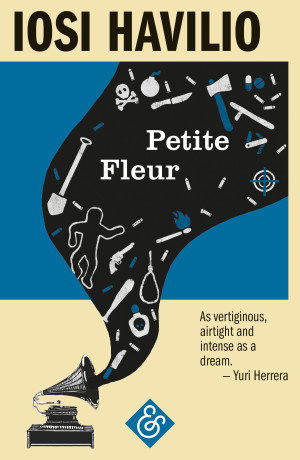You have no items in your cart. Want to get some nice things?
Go shopping Petite Fleur
Petite Fleur
Iosi Havilio
Translated by Lorna Scott Fox
And Other Stories, 2017
128 pp
A fire breaks out, a man is made redundant, a kiss takes place between two strangers, a murder occurs, a woman is stabbed, a couple takes a trip to the seaside. Written in one unbroken paragraph, Petite Fleur accumulates detail until it torques, taking on the rhythm of nightmare. One thing happens after another with an apparent lack of logic, necessity or reason, artificially connected through the continuity of form. Everything reads smoothly, even at moments they should seem disjunctive.
The narrator is thirty-six, an in-between age at which one starts to doubt everything, including the fluid nature of existence. For seemingly no reason, he kills his neighbor Guillermo after visiting his house to borrow a garden spade. The next day Guillermo is back as if nothing has happened. After taking care of practical affairs, such as burying the bloodstained spade, the narrator turns to thinking. What does it all mean? Believing himself to have the gift of resurrection, he begins to investigate the phenomenon:
From the epistles of Paul of Tarsus (‘And if Christ be not risen, then is our preaching vain, and your faith is also vain’) to the Book of Isaiah (‘Thy dead men shall live, together with my dead body shall they arise. Awake and sing, ye that dwell in dust’), from Mayan beliefs to the Lazarus syndrome, from Tolkien’s fantasies to zombie literature, from metempsychosis to series about ghosts, I got myself into a hopeless muddle. Guillermo’s case was so different from all the rest! He didn’t ascend to heaven or grow a pair of wings, there didn’t appear to be any consequences, nor did this herald the end times.
The Russophile narrator remembers Tolstoy’s Resurrection, a parade of anecdotes that go to illustrate the subtle ways that men and women can torture one another, despite the sacred beauty of the earth they are given. Petite Fleur is in some ways a rewriting and response to this novel. Its epigraph comes from the Argentine writer Fogwill’s Help a Él: “Perhaps people never die. / Maybe when dying they hear the name of death / and while it’s still ricocheting, the idea of death, / against the sign and notion of death, / life continues on hold.” The title of the book, Petite Fleur, refers to the Sidney Bechet jazz track that Guillermo puts on just before his carotid artery is slashed.
Attempts at behavioral explanation permeate the narrative, as the narrator seeks to justify his own actions, as well as those of others. At one point, events culminate in what may be the most Argentine sentence ever written: “The solution was to put shame aside and lay my case before a psychiatrist.” We read that “the bond between mother and daughter had deteriorated to a worrying degree ever since Laura had returned to work”, and that “the bond between us had been reduced to a meticulous dramatisation of disaffection”; the narrator worries over a “knotty Oedipus complex”. His wife’s relationship with her father is given a dramatic performance. In a lightly satirized version of a gathering inspired by Lacanian psychiatry, that branch of science in which the past refuses to die, cult leader Horacio leads a group in reenacting their traumas.
A wide and varied cast of characters appear, ranging from the charismatic but egoistic Jodorowsky-inspired “therapist” named Horacio who subjects his group to humiliating rituals that will supposedly cure them, to a teacher named Anika at the Argentine Society for Russian Culture with whom the narrator embarks on an escapade involving medicinal plants and lots of wild sex. (In Havilio’s work the profane and sublime are in constant coexistence.) Ultimately, however, events cluster around three figures – the author, his daughter Antonia, and his wife Laura. This nuclear group, with their far from easy relationship, provide the essential units that combine and recombine to make up the narrator’s world.
In Havilio’s work, anxiety, paranoia and hallucination propel narrative. Behind these forms, another more subtle horror exists – the danger of vast stretches of unfilled time. Time threatens when it becomes a dead space of hours to fill, rather than a productive succession of events. This occurs when the narrator loses his job, as well as when he is transfixed by an accident that seems to stop time. Images of a fire on television enter his dreams. “A sort of paralysis gripped me, physical and spiritual,” he writes. He becomes prey to “chimeras spawned by idleness”, and grows particularly susceptible to images, which he registers and processes with a level of detail so hyper-realistic that it distorts. “The sight of the mountain of rubbish and the scavengers flapping in circles above it moved me to review the last few years of my life,” he writes.
Worst of all was that dreary stretch in the middle of the afternoon, that sluggish, creeping time between lunch and Laura’s return. I entered a black hole in which I could will myself with equal conviction to change the world or to vanish without trace. My spirit had become a permanent hologram. No matter what attitude I tried to take, I’d end up falling into a trap; no initiative ever got beyond the limbo of assertions.
It isn’t entirely clear whether the events described occur in reality or within this “hologram”. But perhaps the disquieting suggestion here is that there really isn’t so much of a difference. The question of how to make the distinct parts of a life connect in a way that seems “real”, parodied as Lacanian psychology, is the genuine concern at the heart of this book. It emerges from the estranging first sentence: “This story begins when I was someone else.” The formal structure of one long paragraph makes everything “falsely” connect, and makes language seem like a lake in which events or people might pop up and disappear, flying fish that hurl themselves upward for a taste of the fresh air before they plunge again into the depths of the sea. Is life so different from Havilio’s mad paragraph? The continued ticking of the minutes make one happening proceed into the next with smoothness, even if they seem disparate. The actions of Havilio’s narrator may seem erratic, but does such a thing as a uniform personality exist?
In a sense, the writhing, propulsive, detail-oriented form of the text is a sort of defense of nightmare and the possibilities for abrupt change it opens up – a highly ambiguous defense, for in the end all the lateral zags produce no change at all. The development is illusory. There does not seem to be such a thing as finality or resolution – in mortality, in relationships, psychoanalysis. Thing simply gives onto thing, and the past can pop up again at any time. Humiliation abounds, and traditional Christian ethics go out the window. What would Tolstoy have made of scenes like this one between the narrator and his wife, filled with passion and sacrifice?
I was thus engaged, lying on top as in an old-fashioned married couple, male over female, when I opened my eyes and met hers, willing, wide and moist. That’s when I remembered the plan, no longer a plan so much as an arcane summons from the beyond. It’s a game, I informed her as I pulled the pillow from under her head and crushed it on her face. The movement was as smooth as the slide of the spade from between the bags of sand and quicklime the first time I killed Guillermo.
The ordinary règles du jeu do not apply. In the nouvelle, translated by Lorna Scott Fox into an English that is lively and entertaining – if occasionally baroque, adding another dissociative element – highly visual language reads almost like notes that have been swept up and shaped. Anecdotes are stacked into a story, and details and scenes are kept that a linear narrative “conceived in advance” would have cut. Objects speak or spur people onto actions, and the narrator never seems truly in possession of himself. “How many other clues were ready to incriminate me at the tops of their voices in the most unsuspected places!” he squeaks. In its subtle strangenesses and jarring juxtapositions, Petite Fleur is a far stranger read than many more deliberately surreal works. Reality itself is incriminated.

About Jessica Sequeira
Jessica Sequeira is a writer and translator from California, currently living in Santiago de Chile.




